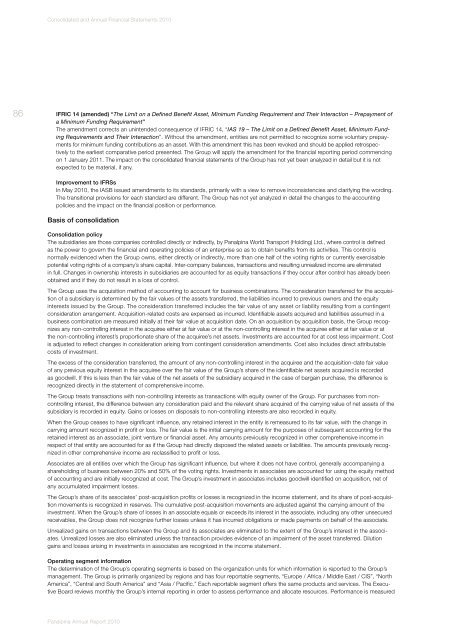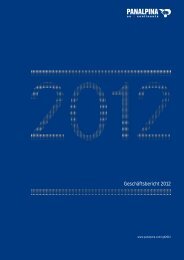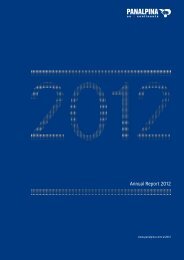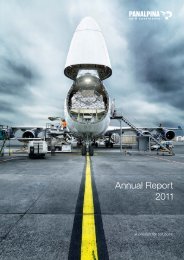Annual Report 2010 (PDF, 5.2MB) - Panalpina Annual Report 2012
Annual Report 2010 (PDF, 5.2MB) - Panalpina Annual Report 2012
Annual Report 2010 (PDF, 5.2MB) - Panalpina Annual Report 2012
Create successful ePaper yourself
Turn your PDF publications into a flip-book with our unique Google optimized e-Paper software.
Consolidated and <strong>Annual</strong> Financial Statements <strong>2010</strong><br />
86<br />
IFRIC 14 (amended) “The Limit on a Defined Benefit Asset, Minimum Funding Requirement and Their Interaction – Prepayment of<br />
a Minimum Funding Requirement”<br />
The amendment corrects an unintended consequence of IFRIC 14, “IAS 19 – The Limit on a Defined Benefit Asset, Minimum Funding<br />
Requirements and Their Interaction”. Without the amendment, entities are not permitted to recognize some voluntary prepayments<br />
for minimum funding contributions as an asset. With this amendment this has been revoked and should be applied retrospec -<br />
tively to the earliest comparative period presented. The Group will apply the amendment for the financial reporting period commencing<br />
on 1 January 2011. The impact on the consolidated financial statements of the Group has not yet been analyzed in detail but it is not<br />
expected to be material, if any.<br />
Improvement to IFRSs<br />
In May <strong>2010</strong>, the IASB issued amendments to its standards, primarily with a view to remove inconsistencies and clarifying the wording.<br />
The transitional provisions for each standard are different. The Group has not yet analyzed in detail the changes to the accounting<br />
policies and the impact on the financial position or performance.<br />
Basis of consolidation<br />
Consolidation policy<br />
The subsidiaries are those companies controlled directly or indirectly, by <strong>Panalpina</strong> World Transport (Holding) Ltd., where control is defined<br />
as the power to govern the financial and operating policies of an enterprise so as to obtain benefits from its activities. This control is<br />
normally evidenced when the Group owns, either directly or indirectly, more than one half of the voting rights or currently exercisable<br />
potential voting rights of a company’s share capital. Inter-company balances, transactions and resulting unrealized income are eliminated<br />
in full. Changes in ownership interests in subsidiaries are accounted for as equity transactions if they occur after control has already been<br />
obtained and if they do not result in a loss of control.<br />
The Group uses the acquisition method of accounting to account for business combinations. The consideration transferred for the acquisition<br />
of a subsidiary is determined by the fair values of the assets transferred, the liabilities incurred to previous owners and the equity<br />
interests issued by the Group. The consideration transferred includes the fair value of any asset or liability resulting from a contingent<br />
consideration arrangement. Acquisition-related costs are expensed as incurred. Identifiable assets acquired and liabilities assumed in a<br />
business combination are measured initially at their fair value at acquisition date. On an acquisition by acquisition basis, the Group recognizes<br />
any non-controlling interest in the acquiree either at fair value or at the non-controlling interest in the acquiree either at fair value or at<br />
the non-controlling interest’s proportionate share of the acquiree’s net assets. Investments are accounted for at cost less impairment. Cost<br />
is adjusted to reflect changes in consideration arising from contingent consideration amendments. Cost also includes direct attributable<br />
costs of investment.<br />
The excess of the consideration transferred, the amount of any non-controlling interest in the acquiree and the acquisition-date fair value<br />
of any previous equity interest in the acquiree over the fair value of the Group’s share of the identifiable net assets acquired is recorded<br />
as goodwill. If this is less than the fair value of the net assets of the subsidiary acquired in the case of bargain purchase, the difference is<br />
recognized directly in the statement of comprehensive income.<br />
The Group treats transactions with non-controlling interests as transactions with equity owner of the Group. For purchases from noncontrolling<br />
interest, the difference between any consideration paid and the relevant share acquired of the carrying value of net assets of the<br />
subsidiary is recorded in equity. Gains or losses on disposals to non-controlling interests are also recorded in equity.<br />
When the Group ceases to have significant influence, any retained interest in the entity is remeasured to its fair value, with the change in<br />
carrying amount recognized in profit or loss. The fair value is the initial carrying amount for the purposes of subsequent accounting for the<br />
retained interest as an associate, joint venture or financial asset. Any amounts previously recognized in other comprehensive income in<br />
respect of that entity are accounted for as if the Group had directly disposed the related assets or liabilities. The amounts previously recognized<br />
in other comprehensive income are reclassified to profit or loss.<br />
Associates are all entities over which the Group has significant influence, but where it does not have control, generally accompanying a<br />
shareholding of business between 20% and 50% of the voting rights. Investments in associates are accounted for using the equity method<br />
of accounting and are initially recognized at cost. The Group’s investment in associates includes goodwill identified on acquisition, net of<br />
any accumulated impairment losses.<br />
The Group’s share of its associates’ post-acquisition profits or losses is recognized in the income statement, and its share of post-acquisition<br />
movements is recognized in reserves. The cumulative post-acquisition movements are adjusted against the carrying amount of the<br />
investment. When the Group’s share of losses in an associate equals or exceeds its interest in the associate, including any other unsecured<br />
receivables, the Group does not recognize further losses unless it has incurred obligations or made payments on behalf of the associate.<br />
Unrealized gains on transactions between the Group and its associates are eliminated to the extent of the Group’s interest in the associates.<br />
Unrealized losses are also eliminated unless the transaction provides evidence of an impairment of the asset transferred. Dilution<br />
gains and losses arising in investments in associates are recognized in the income statement.<br />
Operating segment information<br />
The determination of the Group’s operating segments is based on the organization units for which information is reported to the Group’s<br />
management. The Group is primarily organized by regions and has four reportable segments, “Europe / Africa / Middle East / CIS”, “North<br />
America”, “Central and South America” and “Asia / Pacific.” Each reportable segment offers the same products and services. The Executive<br />
Board reviews monthly the Group’s internal reporting in order to assess performance and allocate resources. Performance is measured<br />
<strong>Panalpina</strong> <strong>Annual</strong> <strong>Report</strong> <strong>2010</strong>






